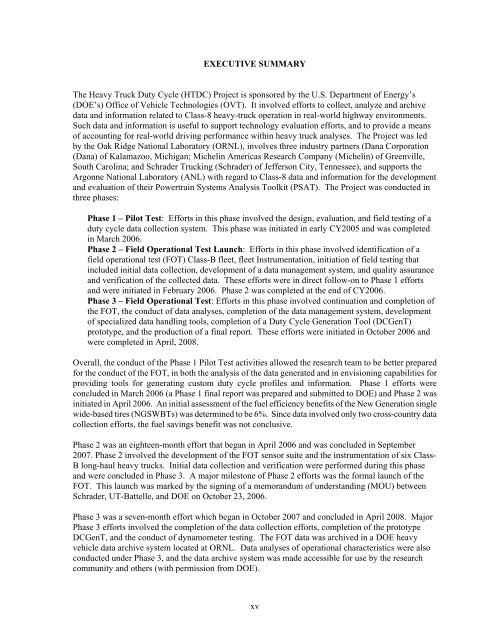Class-8 Heavy Truck Duty Cycle Project Final Report - Center for ...
Class-8 Heavy Truck Duty Cycle Project Final Report - Center for ...
Class-8 Heavy Truck Duty Cycle Project Final Report - Center for ...
You also want an ePaper? Increase the reach of your titles
YUMPU automatically turns print PDFs into web optimized ePapers that Google loves.
EXECUTIVE SUMMARY<br />
The <strong>Heavy</strong> <strong>Truck</strong> <strong>Duty</strong> <strong>Cycle</strong> (HTDC) <strong>Project</strong> is sponsored by the U.S. Department of Energy’s<br />
(DOE’s) Office of Vehicle Technologies (OVT). It involved ef<strong>for</strong>ts to collect, analyze and archive<br />
data and in<strong>for</strong>mation related to <strong>Class</strong>-8 heavy-truck operation in real-world highway environments.<br />
Such data and in<strong>for</strong>mation is useful to support technology evaluation ef<strong>for</strong>ts, and to provide a means<br />
of accounting <strong>for</strong> real-world driving per<strong>for</strong>mance within heavy truck analyses. The <strong>Project</strong> was led<br />
by the Oak Ridge National Laboratory (ORNL), involves three industry partners (Dana Corporation<br />
(Dana) of Kalamazoo, Michigan; Michelin Americas Research Company (Michelin) of Greenville,<br />
South Carolina; and Schrader <strong>Truck</strong>ing (Schrader) of Jefferson City, Tennessee), and supports the<br />
Argonne National Laboratory (ANL) with regard to <strong>Class</strong>-8 data and in<strong>for</strong>mation <strong>for</strong> the development<br />
and evaluation of their Powertrain Systems Analysis Toolkit (PSAT). The <strong>Project</strong> was conducted in<br />
three phases:<br />
Phase 1 – Pilot Test: Ef<strong>for</strong>ts in this phase involved the design, evaluation, and field testing of a<br />
duty cycle data collection system. This phase was initiated in early CY2005 and was completed<br />
in March 2006.<br />
Phase 2 – Field Operational Test Launch: Ef<strong>for</strong>ts in this phase involved identification of a<br />
field operational test (FOT) <strong>Class</strong>-B fleet, fleet Instrumentation, initiation of field testing that<br />
included initial data collection, development of a data management system, and quality assurance<br />
and verification of the collected data. These ef<strong>for</strong>ts were in direct follow-on to Phase 1 ef<strong>for</strong>ts<br />
and were initiated in February 2006. Phase 2 was completed at the end of CY2006.<br />
Phase 3 – Field Operational Test: Ef<strong>for</strong>ts in this phase involved continuation and completion of<br />
the FOT, the conduct of data analyses, completion of the data management system, development<br />
of specialized data handling tools, completion of a <strong>Duty</strong> <strong>Cycle</strong> Generation Tool (DCGenT)<br />
prototype, and the production of a final report. These ef<strong>for</strong>ts were initiated in October 2006 and<br />
were completed in April, 2008.<br />
Overall, the conduct of the Phase 1 Pilot Test activities allowed the research team to be better prepared<br />
<strong>for</strong> the conduct of the FOT, in both the analysis of the data generated and in envisioning capabilities <strong>for</strong><br />
providing tools <strong>for</strong> generating custom duty cycle profiles and in<strong>for</strong>mation. Phase 1 ef<strong>for</strong>ts were<br />
concluded in March 2006 (a Phase 1 final report was prepared and submitted to DOE) and Phase 2 was<br />
initiated in April 2006. An initial assessment of the fuel efficiency benefits of the New Generation single<br />
wide-based tires (NGSWBTs) was determined to be 6%. Since data involved only two cross-country data<br />
collection ef<strong>for</strong>ts, the fuel savings benefit was not conclusive.<br />
Phase 2 was an eighteen-month ef<strong>for</strong>t that began in April 2006 and was concluded in September<br />
2007. Phase 2 involved the development of the FOT sensor suite and the instrumentation of six <strong>Class</strong>-<br />
B long-haul heavy trucks. Initial data collection and verification were per<strong>for</strong>med during this phase<br />
and were concluded in Phase 3. A major milestone of Phase 2 ef<strong>for</strong>ts was the <strong>for</strong>mal launch of the<br />
FOT. This launch was marked by the signing of a memorandum of understanding (MOU) between<br />
Schrader, UT-Battelle, and DOE on October 23, 2006.<br />
Phase 3 was a seven-month ef<strong>for</strong>t which began in October 2007 and concluded in April 2008. Major<br />
Phase 3 ef<strong>for</strong>ts involved the completion of the data collection ef<strong>for</strong>ts, completion of the prototype<br />
DCGenT, and the conduct of dynamometer testing. The FOT data was archived in a DOE heavy<br />
vehicle data archive system located at ORNL. Data analyses of operational characteristics were also<br />
conducted under Phase 3, and the data archive system was made accessible <strong>for</strong> use by the research<br />
community and others (with permission from DOE).<br />
xv
















